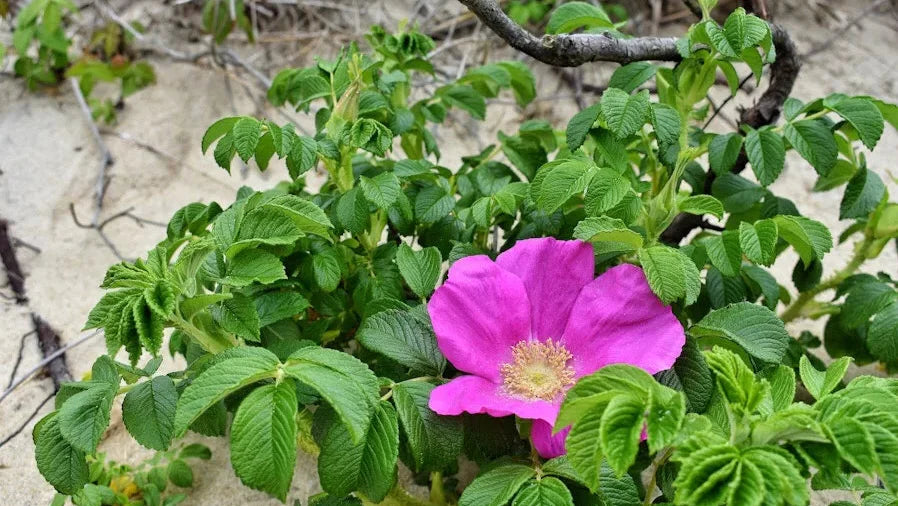
Top 10 Native Plants of Martha’s Vineyard — And Where to Find Them
Share
Martha’s Vineyard isn’t just a coastal paradise; it’s also a botanical treasure trove filled with unique, native plants that thrive in its sandy soils, salt-kissed air, and maritime climate. From wildflowers dotting forest paths to resilient shrubs hugging the coast, these native species support local wildlife, stabilize the island’s ecosystem, and offer incredible beauty in every season.
1. Lowbush Blueberry (Vaccinium angustifolium)
Why it’s special: This hardy, knee-high shrub explodes with white bell-shaped flowers in spring and delivers sweet blue fruit in midsummer—a favorite of both islanders and wildlife.
Where to find it: Scattered throughout Manuel F. Correllus State Forest, especially along sandy fire lanes and open pine barrens.
2. Beach Plum (Prunus maritima)
Why it’s special: This coastal shrub produces fragrant white flowers in May and delicious, tart purple plums by late summer.
Where to find it: Thriving along South Beach and Wasque Point (Chappaquiddick). Look for it in dunes and near beach trails.
3. Eastern Red Cedar (Juniperus virginiana)
Why it’s special: One of the island’s most iconic evergreens, it provides critical shelter for birds and insects while adding texture to the Vineyard’s open landscapes.
Where to find it: Abundant in Katama Plains and Long Point Wildlife Refuge. Look for its silvery-blue berries in fall and winter.
4. Virginia Rose (Rosa virginiana)
Why it’s special: This native rose lights up dunes and meadows with fragrant pink blossoms from June to August. It’s salt-tolerant and bee-friendly.
Where to find it: Found on the coastal bluffs of Aquinnah, and along the trails of Felix Neck Wildlife Sanctuary.
5. New England Aster (Symphyotrichum novae-angliae)
Why it’s special: This vibrant purple wildflower blooms in late summer and early fall, providing nectar to late-season pollinators.
Where to find it: Look for dense patches in open meadows near Squibnocket, and in roadside clearings in West Tisbury.
6. Wild Lupine (Lupinus perennis)
Why it’s special: Not just gorgeous—with tall spires of blue and purple—but also crucial for endangered butterflies like the Karner blue.
Where to find it: Sparsely distributed, but best spotted in oak-pine barrens of Correllus State Forest in late May to June.
7. Switchgrass (Panicum virgatum)
Why it’s special: A native grass with elegant seed heads that support birds and insects. Great for erosion control and restoration.
Where to find it: Common in wetlands around Edgartown Great Pond and along the boardwalks at Cedar Tree Neck Sanctuary.
8. Bloodroot (Sanguinaria canadensis)
Why it’s special: One of the first spring ephemerals to bloom, this white-petaled flower is a fleeting but magical woodland sight.
Where to find it: Polly Hill Arboretum’s native plant gardens and nearby shaded trails host early April displays.
9. Butterfly Milkweed (Asclepias tuberosa)
Why it’s special: With fiery orange blossoms, it’s a monarch magnet and a native wildflower that thrives in sunny meadows.
Where to find it: Long Point Wildlife Refuge and open fields near Lambert’s Cove are excellent viewing spots in mid-summer.
10. Northern Bayberry (Morella pensylvanica)
Why it’s special: Its aromatic leaves and waxy berries are a traditional source of candle wax and food for songbirds.
Where to find it: Grows abundantly along State Road, Menemsha Hills, and in maritime shrub lands across Chappaquiddick.
Why Native Plants Matter
Native plants are the backbone of the island’s ecosystems. They:
Support pollinators and birds
Help manage erosion on the coast
Thrive without fertilizers or pesticides
Preserve Martha’s Vineyard’s natural identity
By learning about and protecting these species, visitors and residents alike help keep the island wild and thriving.
Whether you're hiking, biking, or just soaking in the scenery, keep an eye out for these ten native plant stars that make Martha’s Vineyard such a uniquely wild and beautiful place. Pack your camera, tread lightly, and maybe—just maybe—you’ll catch one in full bloom.
